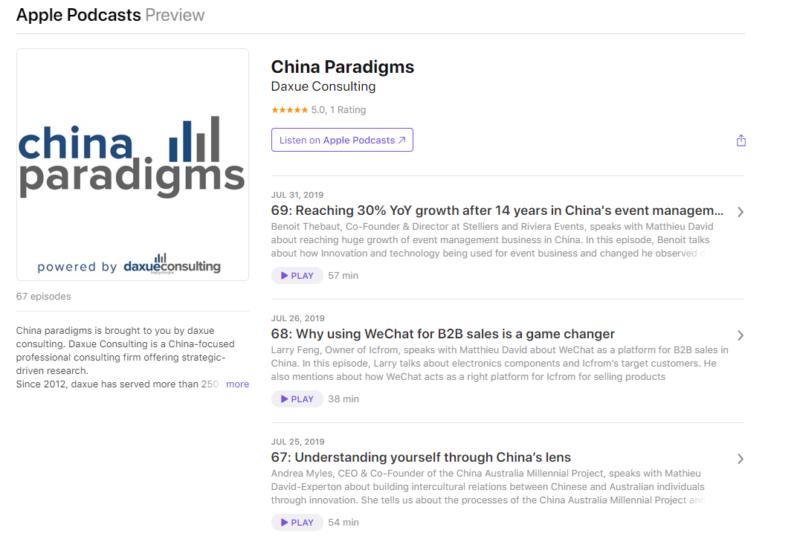What is a special economic zone in China?
In the late 1970s and 1980s, the Chinese began experimenting with capitalism by opening up special economic zones in coastal areas. These special areas were allowed special economic rules separate from the rest of the country. For example, foreign investment and companies in these areas faced lower taxes and the areas had more independence from the central government regarding economic decisions. The purpose of these areas is to drive further economic growth by attracting foreign business, while encouraging domestic companies to export more. Xiong’an new area is the newest special economic zone in China.
A few notable examples of special economic zones in China are Shenzhen, Xiamen, Shantou and Zhuhai, which are all now relatively rich coastal cities in Guangdong and Fujian provinces. Throughout the past few decades, a few sub-municipal regions have been designated special economic zones, such as Shanghai’s Pudong District.
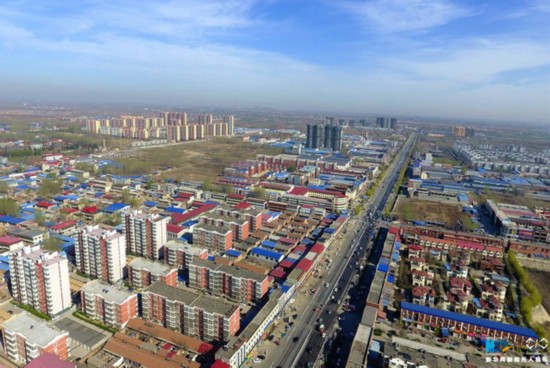
[Aerial photo of Xiongan New Area taken in 2016. The countryside surrounding the built-up areas are largely undeveloped. Source – Xinhua.]
How has the designation of Xiong’an New Area affected business in China?
In the spring of 2017, President Xi Jinping announced plans for a new special economic zone in China. Located about 100 kilometers south of Beijing, Xiong’an New Area is an ambitious plan to shift the focus of economic and political power outside of the crowded Chinese capital. Xiong’an New Area is located in the center of Jingjinji, a larger region that consists of Beijing (Jing,) Tianjin (Jin) and Hebei (Ji.) The population of this area is already greater than 100 million.
Due to Xiong’an New Area’s strategic location in the middle of the Jingjinji area, it is amassing large amounts of investments. A projection by Morgan Stanley estimated that Xiong’an New Area could draw in investment totaling 2.4 trillion yuan in the coming years. This investment will consist of infrastructure, pilot schemes, nature preservation and the development of certain sectors that are key to the city’s development. Xiong’an New Area has already attracted a heavy dose of investment from the central government, mostly in the form of infrastructure development. It is expected to invest 600 billion yuan in infrastructure in the region before 2020.
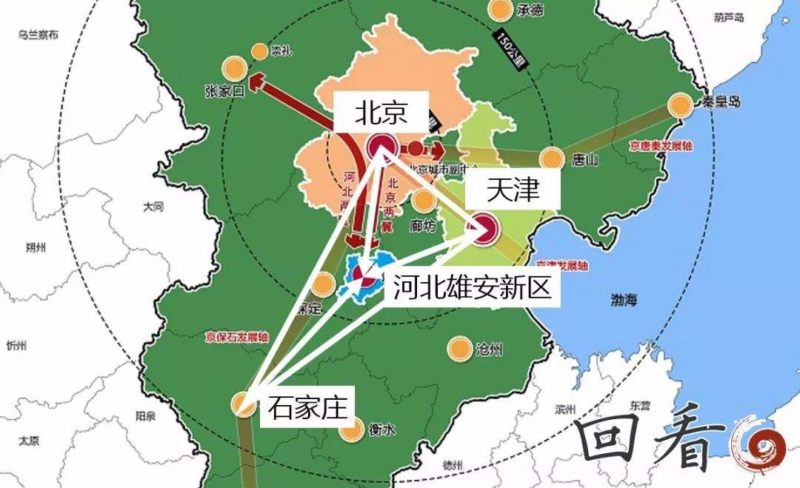
[This map shows the location of Xiong’an at the center of a triangle formed by three other major cities in Northern China: Beijing, Tianjin and Shijiazhuang. The region forms the Jingjinji region, which has a population of more than 100 million people. Source – Huikan]
Population projections also show that Xiong’an New Area is likely to attract a large influx of residents as it is developed over the coming years. The population of the area is currently only around 1 million, most of which is classified as rural. Estimates on future population levels vary, but according to some government estimates, the city will have more than 5 million people.
Last year, the Chinese government released a master plan for Xiong’an New Area, which shows the influence that officials hope the city will have in the future. The master plan highlights the importance of green development in the city’s future. It also lays out a plan to develop the city into a leading center of technology and science.

[Two views of Shenzhen that demonstrate the potential growth for SEZs in China. One in the 1970s and the other in the 2010s. The first photo, taken before Shenzhen was designated as a Chinese special economic zone, shows a collection of low-rise apartment buildings surrounded by smaller structure. The second scene tells a different story. These two images illustrate the potential of Xiong’an New Area. Source – Reddit. ]
Special Economic Zones in China have a track record of wild success
Xiong’an New Area is far from being the first special economic zone in China. A few of the most successful regions of China today were in fact nothing more than villages in the past. They enjoyed the wild success that we see today because of their designation as a Chinese special economic zone. These areas include Pudong district in Shanghai as well as the entire city of Shenzhen.
In the past, Shenzhen was just a remote fishing village located near the Pearl River Delta between Guangzhou and Hong Kong. All that changed when then Premier Deng Xiaoping designated the area as a Special Economic Zone in May of 1980. Since then, the city has experienced wild population and economic growth. As shows in the photos above, the landscape of Shenzhen has also changed dramatically as a result.
The other shining example of the staggering success of special economic zones in China is Shanghai’s Pudong district. Designated in 1992, the status of special economic zone helped Pudong develop rapidly into the financial center it is today. Before the designation, the majority of economic and human movement in Shanghai was centered on Huangpu, across the river. Today however, millions of people live and work in Pudong.
Xiong’an New Area is of course different from these two places, but some of the same factors that led to their success are also present in Xiong’an: people and proximity to existing economic centers.
Chinese pilot schemes are developing rural Hebei Province’s technology and financial capabilities
Chinese Pilot schemes are helping bring attention and more development to Xiong’an New Area by forging technology, financial and green development links. In 2018, the City of London announced the establishment of the China-U.K. Green Finance Center, which features a pilot project in Xiong’an New Area that will focus on the development of green finance.
Other Chinese pilot schemes worth noting in Xiong’an New Area are shaping other sectors, such as the digital economy. In late 2017, Baidu announced it would be starting its own pilot project in the city to develop AI technology. And last month, the local government of Xiong’an announced it would construct its own pilot zone to promote innovation in the digital economy.
Together, these and other Chinese pilot schemes are likely to have a lasting effect on the development of technology, finance and other industries in the city. Already, some area attracting foreign entities into the city, which shows that Xiong’an may continue to attract foreign business in these fields.
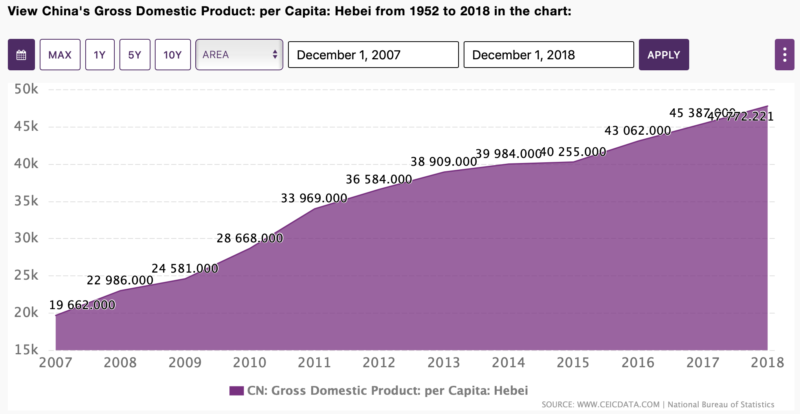
[Chart showing the sharp increase in GDP per capita across Hebei province. Source – National Bureau of Statistics.]
Hebei’s Economic Catch-up and Chinese Poverty Alleviation Policies may drive Xiong’an’s growth
One of the reasons for the designation of Xiong’an New Area may indeed be flattening regional disparities, which are especially stark between Tianjin, Beijing and the surrounding countryside. In recent years, such regional disparities have been the cause for growing concern. Integrating the region into a larger urban entity would go a long way to reduce the disparity between poor and rich. This being said, there are critics who claim that Xiong’an will not be able to pull this off easily, as it does not have the same advantages as other special economic zones in China.
While there are similarities between Shenzhen, Pudong and Xiong’an New Area, some doubt the potential of Xiong’an, citing concrete arguments such as the existence of many other special economic zones and China’s slowing GDP growth rates. However, others point to the grisly truth that Xiong’an is located in one of the poorest regions in Eastern China. Adjacent to the super-affluent cities of Beijing and Tianjin, Hebei is markedly poorer than its glitzy neighbors, with GDP per capita in Hebei less than half the level of the neighboring cities.
Some point out that even though Xiong’an may have a harder time developing as fast as Shenzhen and Pudong, its base is lower than those special economic zones were when they were first designated. This means the potential for economic growth is higher in Xiong’an New Area.
Chinese poverty alleviation policies have already had a lasting effect on the country as a whole, but most notably in poorer provinces such as Hebei. As recently as 2018, Hebei province announced it had lifted 648,000 people out of poverty in one year. China’s poverty alleviation policies combined with the designation of Xiong’an New Area may accelerate growth in the area in the coming years, which may provide great incentives for foreign companies looking to expand in Northern China.

[View of the newly completed Beijing Daxing Airport. Located between Beijing and Xiong’an, the airport will serve both as a second airport for the growing aviation market in Beijing and as a hub for the larger Jingjinji area. The airport will be connected to Xiong’an New Area by expressway and high-speed rail. Source – Hangkong Wuyu]
Infrastructure Investment in Xiong’an New Area is boosting business opportunities
In September, Beijing’s new international airport opened about 40 kilometers south of the capital. Daxing International Airport’s terminal one building is one of the largest airport terminals in the world and is only the first terminal in the airport’s long-term plan. The airport is expected to be one of the busiest airports in the world. Unsurprisingly, the airport is located between Beijing and Xiong’an New Area, perhaps in anticipation of the development of the new city. Direct flights between the new airport and numerous foreign cities are anticipated.
South of the glitzy new airport, construction of Xiong’an’s High-speed rail station is scheduled to complete in 2020. The station is part of the intercity high-speed rail line that connects the new airport to Beijing South Station. Once completed, passengers can travel between Xiong’an New Area and Beijing or Tianjin within 30 minutes. Further plans will connect the city with Shijiazhuang to the south.
In addition to shiny new airport and high-speed rail lines, Hebei province is working on constructing canals that will connect Xiong’an to Beijing and Tianjin. This would not only link Xiong’an New Area to the Beijing by water routes, but it could also open Xiong’an up to maritime trade. Whether it be air, rail or water, these improved transport links over the coming years will only make Xiong’an New Area more accessible to domestic travelers as well as foreign companies.
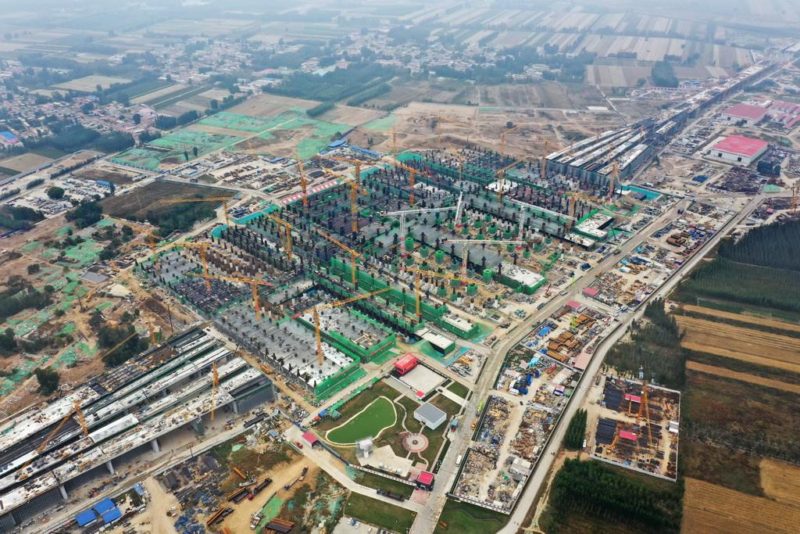
[Aerial view of the construction site of Xiong’an New Area’s high-speed rail station. Expected to be completed in 2020, the station will be one of the largest in the Jingjinji region. Source – Xinhua]
Could Xiong’an New Area be a home to foreign companies
Foreign companies looking to expand into Xiong’an New Area need to see the long-term strategy of the Chinese government in developing this area. Despite the relatively low speed at which Xiong’an is developing, the plans for the city are long-term and grand by nature. In addition, Xiong’an New Area’s position in the center of the Jingjinji area gives it a huge advantage in terms of development potential.
Looking at the development of past economic zones, such as Shenzhen and Pudong, will help foreign companies succeed in Xiong’an New Area. Seeing how the two cities benefitted from similar designations over time is a way that companies can predict how best to benefit from the city’s development.
Finally, looking at trends across China will also help foreign companies looking to expand into the Jingjinji region. Chinese pilot schemes and Chinese poverty alleviation policies have increasingly become synonymous with development in general. Understanding how these factors affect the Chinese economy will be crucial for companies.
Let China Paradigm have a positive impact on your business!
Listen to China Paradigm on iTunes
